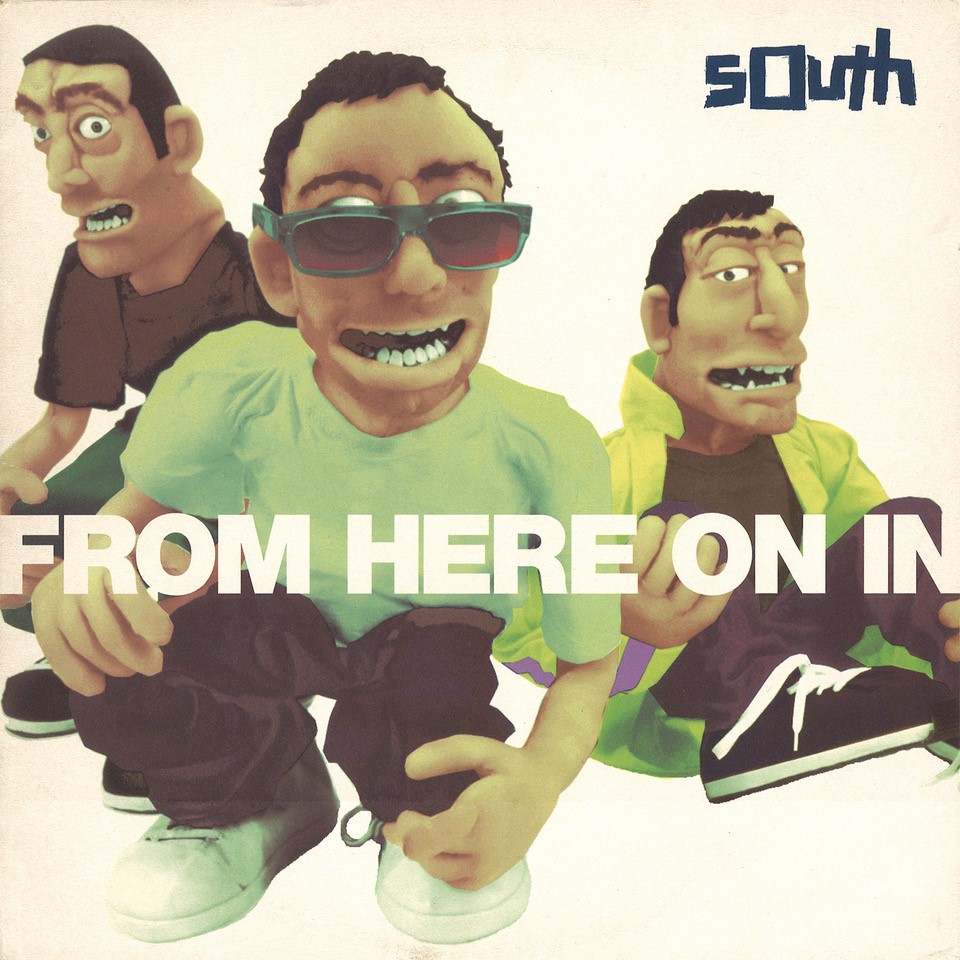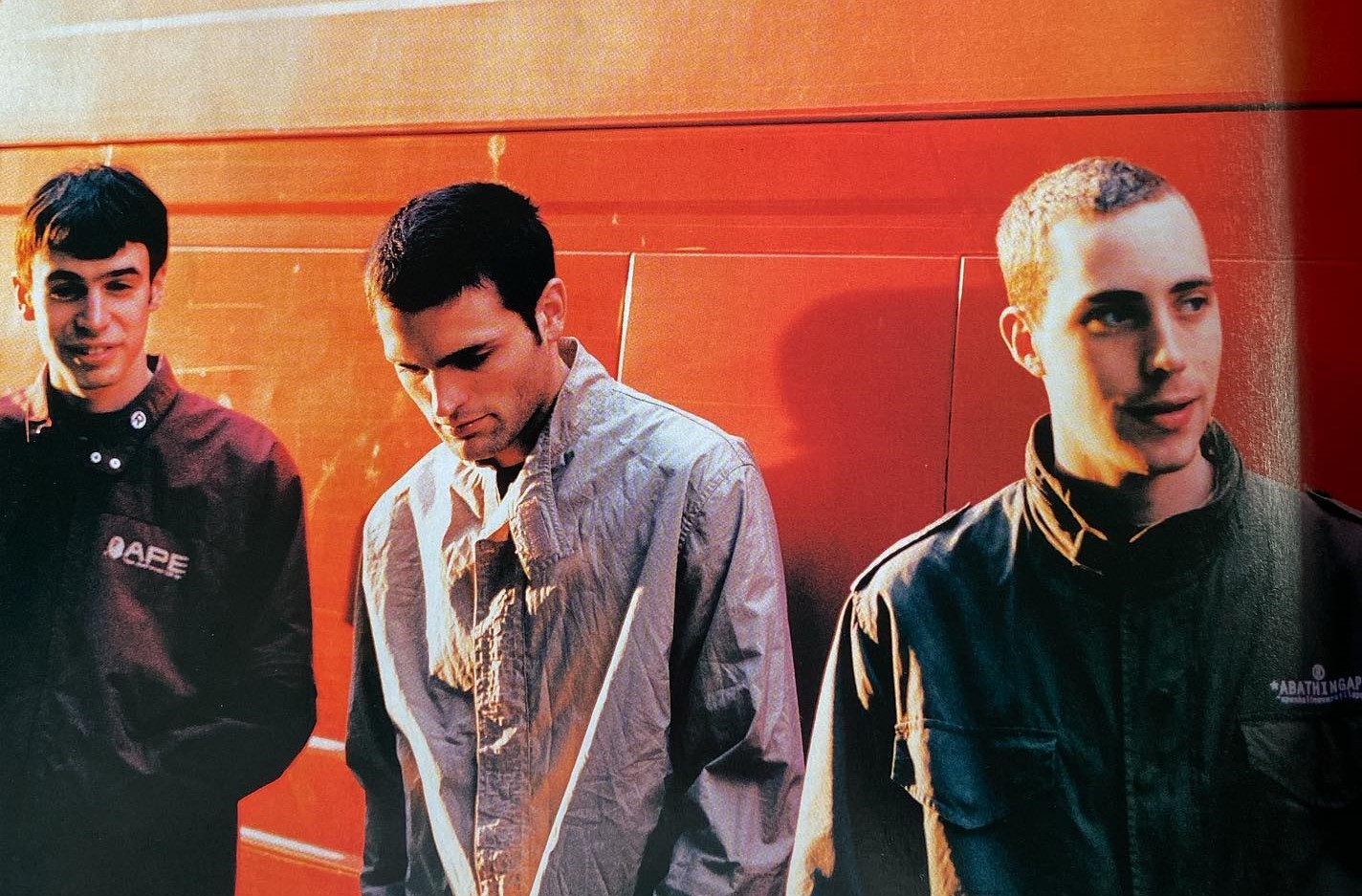Time has become relative these days … and I’m not talking about our everyday pandemic lifestyle where every day feels pretty much the same. The digitalization of music also detached this form of art from time. Within two clicks you can switch from a contemporary pop smasher to an obscure 70s psychedelic rock opus, thus freeing your personal musical experience from a record’s actual release history. From Here On In by South came out twenty years ago but can be easily discovered for the first time these days, thanks to the power of the internet. And the timelessly beautiful songs on it surely deserve a second coming. What? You never heard of this band before? Well, you’re not the only one but if you’re up for quality melody-loving psychedelic Britpop with electronica influences you’re in for a treat, believe me.
Hailing from North London the band South only existed for a little more than a decade. Between 1998 and 2008 Joel Cadbury, Brett Shaw and Jamie McDonald released four studio albums, toured the world but then vanished back into the realms of British music history, only to now re-surface with a 20th anniversary edition of their 2001 debut album From Here On In. In the wake of that release I reached out to the group’s Jamie McDonald to talk about that record and the band of which I really became a fan over the past years. In an ironic twist I forecasted the Spotify age and discovered the music of South in a very non-chronological order. The first album I fell in love with was actually their second – 2003’s With The Tides – but since I discovered this one three years after its original release my next album was actually the band’s final one – 2008’s You Are Here. In the end I actually listened to From Here On In for the first time only five, six years ago; so although the band disbanded over a decade ago they never really left my side in the past fifteen years – and somehow it’s the same for the band as Jamie tells me: “It was always a lovely thing to know that people still listened and thought about music that we had worked incredibly hard on and cared about.” In the wake of the album’s re-release the band reactivated their social media activities and for Jamie it was pretty heart-warming to hear all the stories of the fans who are still very much connected to the music.
From Here On In is not an ‘in-your-face’ hit album but even two decades later it’s a warm, honest and cohesive work of melodic guitar music. Each member was a multi-instrumentalist with shared duties on pretty much all instruments. There’s a high level of musicality that shines through the music and maybe that makes the difference when it comes to the emotional effect of the music. The trio formed at Haverstock School in Chalk Farm, a stone’s throw from Camden Town and according to Jamie they were around 13, 14 when they started hanging around and playing music. Obviously, forming a band felt like a logical consequence here.
“We loved music and went pretty quickly from playing other peoples songs to writing our own …. we just loved music, guitars, beats, records, and we just wanted to get better….we played our first gig underage at the Monarch (which became the Barfly) on Chalk Farm Road, we can’t have been particularly good! But we packed the place out with our friends (underage also) and it was a great gig so we wanted to do it again but better and to more people…… we were off.”

From left to right: Brett Shaw, Joel Cadbury, Jamie McDonald (Photo by Marcus Clackson)
For Joel, Brett and Jamie music was the motivation but please remember that these were the days before the internet and even the best bedroom band project wouldn’t make it if it wasn’t for the power of the good ol’ record label that helped them to get an audience. Times were simpler, yet ultimately tougher and a band really needed to be as good as South to get discovered but even then having success remained a lucky shot. South originally saw themselves as an electronic act, before morphing into a more traditional band but they never lost track of these electronic roots and lucky for them Mo’Wax founder and U.N.K.L.E. mastermind James Lavelle was actually looking for a band on his label rather than another electronic act. “In those days the idea was you could get a publishing deal first, the money from which you could use to develop your sound, write a bit more,” Jamie explains the order back then.
The band got a regular spot at the St Moritz Club on the legendary Wardour Street in 1998. Within a few weeks they had signed a publishing deal with Warner Chappell which allowed them to work on their music, get new instruments and simply get better at their craft. And they were lucky enough to have a manager like John Brice who sealed the deal with Lavelle. Brice was also the person who first approached the idea of any anniversary activities to the band. That suggestion made Jamie revisit From Here On In for the first time in ages and suddenly all the memories came back: “I felt very warm and happy, I guess that might be pride. Remembering how hard we worked on those songs and that album, that we took it seriously and we did a good job.”
The early days of the digital age
The album is pretty mighty; 16-tracks strong with a few reprises, interludes and the three-parted Broken Head track that frames the entire thing. It really feels like a cohesive piece of work and a proper album concept but according to Jamie that wasn’t the intention. “It was something that came together during the making of the record.” The tiny electronic interludes were pretty much a result of working with producer Damian Taylor in the studio who first introduced the band to Pro Tools. From a pop historic point of view From Here On In happened at an interesting time since it was the beginning of digital recording techniques. The tools were still in early stages though.
“Sometimes it would take hours to do something that today would take seconds but it was an incredible facility for us to suddenly have and a new way of working which we embraced … We had a very young but none the less brilliant Damian Taylor working with us as Pro Tools engineer and he contributed a hell of a lot to the sound and direction of the record and to the scoring of the movie ‘Sexy Beast’ which we did while in the middle of the album sessions.”
According to Jamie’s memories the Wessex studio had an amazing desk, an epic microphone collection and a selection of pre amps that they were using before going into the computer. In the end they mastered the entire record onto tape. It’s the best of both worlds, actually. At the turn of the century the world looked way different and sometimes it helps to remember that and how far we’ve come in such short time when it comes to technology. South also emerged into a changing British music landscape. They high times of 90s Britpop were gone, new bands like Travis and Coldplay took a smoother route while established ones like Blur and Radiohead tried to free themselves from the Britpop chains by embracing electronic elements. The band formed during the same time as groups like Doves and Elbow who also gave their music a few electronic twists, experimented with trip-hop beats and elements of dance music. South had a pretty tight connection with Elbow who also toured with them in those early days. However, Jamie isn’t really sure whether they were actually part of a scene back then. “I felt like the electronics were something we embraced as we evolved rather than them being part of the catalyst of our sound,” he explains to me. “In my mind we were always inspired by the idea of a song, a beat and atmospherics but created from instruments….going back through demos in the years leading up to From Here On In it was really apparent who our influences were – The Verve, The Charlatans, Stone Roses, mixed with Neil Young, The Lemonheads, Nirvana.” The electronic infusion actually happened as they approached the recording process. Along with the re-release of their debut album the band also released From Here On Out, a compilation of demos, B-Sides and bonus tracks from that era which might actually give you a better understanding of these roots.
 The gentle opening track Paint The Silence gained a certain momentum a few years later when it was prominently featured in the popular US series The O.C. “There was quite a bit more whooping when we played it live,” the artist remembers before adding “That song will put our kids through college.” However, From Here On In – and its follow ups – weren’t big successes despite all being really good if you ask for my humble opinion. South never became as big as Elbow, Doves and others of their generation and I never understood why. If you take a track like Paint The Silence or the mighty Here On In (a personal favourite of Guy Garvey as Jamie recalls) or Colours In Waves from their sophomore album you really have to wonder. There are always multiple factors that decide why something is successful and why not. For Jamie it’s not easy to answer the question why they never had their big breakthrough.
The gentle opening track Paint The Silence gained a certain momentum a few years later when it was prominently featured in the popular US series The O.C. “There was quite a bit more whooping when we played it live,” the artist remembers before adding “That song will put our kids through college.” However, From Here On In – and its follow ups – weren’t big successes despite all being really good if you ask for my humble opinion. South never became as big as Elbow, Doves and others of their generation and I never understood why. If you take a track like Paint The Silence or the mighty Here On In (a personal favourite of Guy Garvey as Jamie recalls) or Colours In Waves from their sophomore album you really have to wonder. There are always multiple factors that decide why something is successful and why not. For Jamie it’s not easy to answer the question why they never had their big breakthrough.
“Every band should be proud of the music they make and be confident that people will want to hear it…. I was. Did I want to be bigger? For sure. I loved our music and loved playing in front of people, so I wanted to play in front of as many people as possible and then keep going…..as for why we weren’t bigger than we were – I could be up all night thinking about that one, but what’s the point of regrets? We did a lot in our time, and I am really proud of the music we made and look back fondly on those years which, apart from having kids and all that, were the most exciting of years of my life!”
Then Jamie remembers a time when they kept iconic British radio DJ John Peel up all night when South were staying in the room above him at an ‘All tomorrows party’ festival. In Joel’s memories he was quite pissed and as a result apparently voted against South being played on radio after that. In a time when airplay was still very important it might have been a game changer. Or maybe not. It’s a bit pointless to think about that. In the end, after a little more than ten years the band had run its natural course and got a bit bored of each other and the dynamic that had evolved as Jamie recalls it. “The last record we made felt like we each contributed four songs to it and knew what we wanted for those songs rather than it being as collaborative a process as it had been previously. I really love everyone’s songs on that album but they sound like they’re from different records. I just think we were all ready to spend a bit of time on other things, and that’s totally ok.” Well… and here we are, almost thirteen years later. The vibe between the three lifelong friends is still pretty good as Joel explains: “We meet up when we can, we holiday together and we are all still part of a wider group of friends who have known each other a long time.” For them South will always be a big piece of their hearts and lives. Still, it’s a chapter of the past but he adds a tiny “for now” to that conclusion, leaving the door open for the trio to maybe resurface again one day. Until then, there’s still a lot of music waiting from them to be discovered. Consider me quite hyped about the From Here On Out bonus album because I barely know any tracks from this one.

South back in 2001. Photo by Neil Massey for Fader Magazine
From Here On In feels like a warm fever dream. Some might argue it’s musically outdated but if you take a closer look at it it’s not that far away from all the contemporary psychedelic rock groups and dream pop acts that surfaced over the past years. Jamie’s still very proud of the sound: “It’s just a window into the time of South at that moment, the people we were working with and how we physically went about recording.” I personally always loved Live Between The Lines (Back Again) and for Jamie All In For Nothing at the end of the album feels like the perfect sum-up of the South sound at the time “Big song, banging beat, a groove, jagged acoustic melodies.”
It’s a an album that invites the listener to discover a fascinating musical cosmos. And I think for me personally it’s this special form of musicality that triggers something in me. As a fan of combining guitars, melody and electronic elements it’s easy to seek for assistance in the countless digital tools these days – but this is an album where all these elements were performed by very talented musicians, gifted songwriters and put together in a very raw and physical way. The older I get the more I appreciate that approach since it works as an artistic antidote to our fast-paced musical landscape in 2021 which appears to be more focussed on repetitive formulas, algorithm optimizing and simply releasing music because you can. Actual musical skills and that special analogue human factor can make a difference here and if you share a similar longing these days maybe now is the best time to discover a band like South with From Here On In being the perfect gateway drug. In a time when … well, time itself becomes relative and everyone is looking for a slightly different life beyond the pandemic horizon this little throwback might provide you with the musical and emotional strength to get through all this.
Both South re-releases are limited to just 500 vinyl copies and are out now on double vinyl via Club AC30.
From Here On In – Order Here
From Here On Out – Order Here
From Here On In & Out Bundle – Order Here



